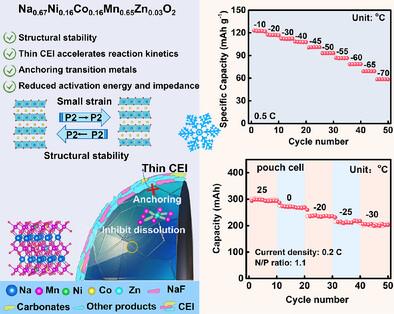Optimising Orbital Hybridization Induced Quenching Multistage Phase Transitions and Enhancing Redox Kinetics for Ultralow-Temperature (−70 °C) Sodium Storage
IF 19
1区 材料科学
Q1 CHEMISTRY, MULTIDISCIPLINARY
引用次数: 0
Abstract
The unfavorable phase transitions and sluggish low-temperature kinetics dramatical constrain the application of sodium-ion batteries (SIBs). The deep-seated relationship between the unfavorable phase transition and low-temperature kinetics of pouch cell need to be well revealed. Herein, Zinc (Zn)-doping is introduced to optimize the hybridization of oxygen (O) 2p and transition metal (TM) 3d orbitals in Na0.67Ni0.16Co0.16Mn0.67O2. This increases the degree of disorder between the Zn 3d and manganese (Mn) 3d states near the Fermi level, thereby disrupting the ordering of Na+ vacancies, forestalling multiphase transitions (P2’ and OP4) and the Jahn–Teller distortion. Remarkably, this approach simultaneously enhances the redox reversibility of cathode materials while mitigating irreversible TM migration. Through optimized orbital hybridization, the activation energy and impedance are significantly reduced, accelerating the rapid storage of Na+ at ultralow temperature (−70 °C). The hardcarbon || Na0.67Ni0.16Co0.16Mn0.65Zn0.03O2 (RMNC-2) pouch cell exhibits great practical potential with high average capacity (486 mAh), high energy density (207 Wh kg−1 based on total weight of cathodes and anodes), and durability for low temperature. This research offers valuable insights into up-recycling spent cathodes of lithium-ion batteries (LIBs) for sustainable cathodes of SIBs in pouch cells, with a particular focus on their compatibility across ultralow temperature.

优化轨道杂交诱导的猝灭多阶段相变和提高超低温(- 70°C)钠储存的氧化还原动力学
不利的相变和缓慢的低温动力学极大地限制了钠离子电池的应用。袋状电池的不利相变与低温动力学之间的深层关系有待进一步研究。本文引入锌掺杂优化了Na0.67Ni0.16Co0.16Mn0.67O2中氧(O) 2p和过渡金属(TM) 3d轨道的杂化。这增加了Zn 3d和锰(Mn) 3d态在费米能级附近的无序程度,从而破坏了Na+空位的有序,阻止了多相转变(P2 '和OP4)和Jahn-Teller畸变。值得注意的是,这种方法同时增强了阴极材料的氧化还原可逆性,同时减轻了不可逆的TM迁移。通过优化轨道杂化,显著降低了激活能和阻抗,加速了Na+在超低温(- 70℃)下的快速存储。硬碳|| na0.67 ni0.16 co0.16 mn0.65 zn0.030 o2 (RMNC-2)袋状电池具有高平均容量(486 mAh)、高能量密度(基于阴极和阳极总重量的207 Wh kg−1)和低温耐用性,具有很大的实用潜力。这项研究为将废锂离子电池(lib)的阴极向上回收用于袋式电池中sib的可持续阴极提供了有价值的见解,特别关注它们在超低温下的兼容性。
本文章由计算机程序翻译,如有差异,请以英文原文为准。
求助全文
约1分钟内获得全文
求助全文
来源期刊

Advanced Functional Materials
工程技术-材料科学:综合
CiteScore
29.50
自引率
4.20%
发文量
2086
审稿时长
2.1 months
期刊介绍:
Firmly established as a top-tier materials science journal, Advanced Functional Materials reports breakthrough research in all aspects of materials science, including nanotechnology, chemistry, physics, and biology every week.
Advanced Functional Materials is known for its rapid and fair peer review, quality content, and high impact, making it the first choice of the international materials science community.
 求助内容:
求助内容: 应助结果提醒方式:
应助结果提醒方式:


